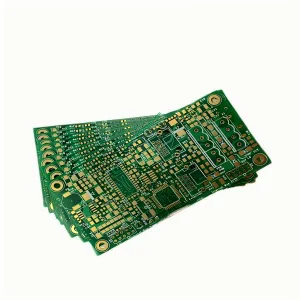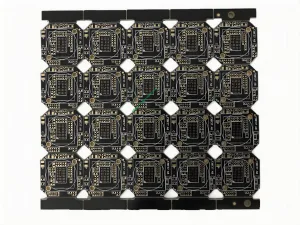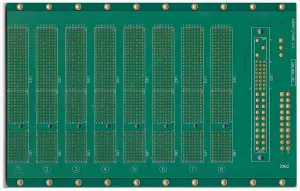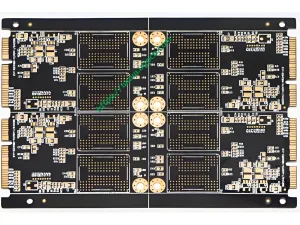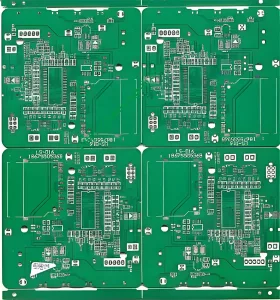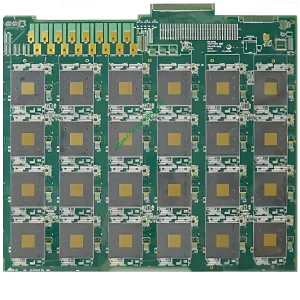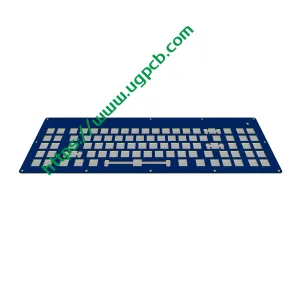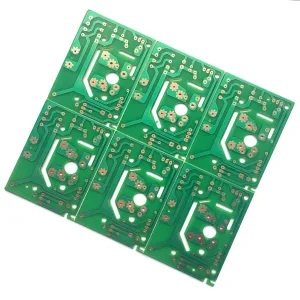FR4 é um símbolo para o grau de material retardador de chama, o que significa uma especificação de material na qual o material da resina deve se extinguir após a queima. Não é um nome material, Mas uma nota material.
Atualmente, Existem muitos tipos de materiais de grau FR-4 usados em placas de circuito impresso, Mas a maioria deles são materiais compostos feitos da chamada resina epóxi de função de tera com fibras de enchimento e vidro. Portanto, os fabricantes de PCBs são usados para se referir a este PCB feito de resina epóxi e fibra de vidro como PCB FR4.
Material de PCB FR4 é uma placa de pica de vidro de resina epóxi com cobertura de cobre, que pertence a toda a fibra de vidro. Geralmente é usado para produzir placas de circuito de dupla face e placas de circuito multicamadas.
O material de PCB FR-4 é dividido nos seguintes níveis.
1. FR-4 Classe A1 Laminado de cobre
Este nível é usado principalmente na indústria militar, comunicação, computador, circuito digital, Instrumento industrial, circuitos de automóveis, e outros produtos eletrônicos. A qualidade desta série de produtos atingiu totalmente o nível de classe mundial, a nota mais alta, e o melhor desempenho.
2. FR-4 A2 Laminado revestido de cobre
Este nível é usado principalmente para computadores comuns, instrumentos e medidores, Aparelhos domésticos avançados, e produtos eletrônicos gerais. Esta série de laminados vestidos de cobre são amplamente utilizados, e todos os índices de desempenho podem atender às necessidades de produtos eletrônicos industriais gerais. Há um bom preço
Taxa de desempenho. Pode permitir que os clientes melhorem efetivamente a competitividade de preços.
3. FR-4 A3 Laminado revestido de cobre
Este grau de laminado vestido de cobre é um produto FR-4 desenvolvido e produzido pela empresa para a indústria de eletrodomésticos, Produtos periféricos do computador, e produtos eletrônicos comuns (como brinquedos, calculadoras, Consoles de jogos, etc.). É caracterizado pelo preço extremamente baixo da premissa de que o desempenho atende aos requisitos
Vantagem competitiva.
4. FR-4 A4 Laminado revestido de cobre
Este grau de placa pertence ao material de baixo custo do laminado FR-4 de cobre. No entanto, Os indicadores de desempenho ainda podem atender às necessidades dos eletrodomésticos comuns, computadores, e produtos eletrônicos gerais. Seu preço é o mais competitivo, e a taxa de preço de desempenho também é excelente.
5. FR-4 Classe B Laminado revestido de cobre
Esta nota da placa de PCB é relativamente ruim e tem estabilidade de baixa qualidade. Não é adequado para produtos de placa de circuito com grandes áreas. Geralmente, É adequado para produtos com tamanho de 100mmx200mm. Seu preço é o mais barato, Portanto, devemos prestar atenção à sua seleção e usar.
As placas de circuito impresso FR4 podem ser divididas nas seguintes categorias de acordo com suas funções. Placas de circuito de um lado, Placas de circuito de dupla face, Placas de circuito multicamadas, Placas de circuito de impedância, etc.. As matérias -primas das placas de circuito são divididas em placas de fibra de vidro FR4, etc., que são produzidos em nossa vida diária.
Pode ser visto de fontes vivas. Por exemplo, O núcleo de pano à prova de fogo e feltro à prova de fogo é fibra de vidro. A fibra de vidro é fácil de ser combinada com resina. Mergulhamos o pano de fibra de vidro com estrutura compacta e alta resistência na resina e o endurecemos para obter isolamento térmico e não insolação
Substrato de PCB flexível — Se a placa da PCB estiver quebrada, A borda é branca e em camadas, o que é suficiente para provar que o material é fibra de vidro de resina.
Placa de circuito impresso FR4
(1) Aparência. FR4 PCB = substrato (isolamento) + circuito.
(2) Função. A função do PCB FR4 é esqueleto e conexão. O objetivo final é conectar todos os componentes de acordo com o diagrama de circuito correto para formar um circuito de trabalho completo.
(3) Composição e material. O material de substrato comumente usado é FR4 (fibra de vidro), e o FR PCB é composto de várias camadas (painel único, placa de dupla face, placa de quatro camadas, Placa de oito camadas, 12 camadas, 16 camadas, e 24 Camadas PCB).
(4) Um circuito impresso é na verdade um circuito formado pela impressão de uma camada de material condutor na superfície de um substrato não condutor de acordo com a composição do circuito. Finalmente, Um núcleo FR4 não condutivo é formado dentro, e uma camada de cobre (padrão) constituindo o circuito é formado fora
O termo é revestimento de cobre). Para evitar oxidação ou condutor de cobre com o exterior, há uma camada de tinta do lado de fora. Ao escovar a tinta, Os pontos de soldagem devem ser expostos (Geralmente existem dois tipos de pontos de soldagem. um é o tipo pino e o outro é o tipo de patch). Os pontos de soldagem são de cobre
Mas geralmente fazemos tonalidade para a conveniência da soldagem.
O substrato de PCB geralmente é fibra de vidro. Na maioria dos casos, o substrato de fibra de vidro da PCB geralmente se refere a “FR4”. “FR4” Este material sólido fornece dureza e espessura da PCB. Além do FR4, há flexibilidade
Placas de circuito flexíveis produzidas em plásticos de alta temperatura (poliimida ou similar), etc..
PCB e orifício baratos FR4 (Veja a figura acima) são feitos de materiais como resina epóxi ou fenol. Eles não têm a durabilidade do FR4, Mas eles são muito mais baratos. Quando você soldou coisas nesta placa, você vai cheirar muitos cheiros peculiares. Este tipo.
O substrato é frequentemente usado em bens de consumo muito baixos. Os fenóis têm baixa temperatura de decomposição térmica, E o tempo de soldagem muito longo levará à sua decomposição e carbonização, e emite um cheiro desagradável.
Comparado com a placa de alta velocidade, PCB FR4 comum tem maior atenuação ao sinal de onda senoidal, especialmente para harmônicos de alta frequência. Porque os sinais digitais são sintetizados por ondas senoidais de diferentes frequências. A atenuação da onda senoidal levará à necessidade de transmissão A degradação da borda e redução de amplitude do sinal afetam a largura de banda da linha de transmissão. O uso de um PCB de alta velocidade pode reduzir a perda de linha de transmissão por unidade de comprimento. Portanto, Quando o comprimento da linha é o mesmo, A placa de alta velocidade pode tornar a largura de banda da linha de transmissão mais alta, maior margem de sinal. De forma similar. Sob os mesmos requisitos de perda, O uso de uma PCB de alta velocidade pode levar um roteamento mais longo, e o desempenho ainda atende aos requisitos.
A placa de circuito multi-camada FR4 geralmente é usada para produtos eletrônicos de ponta. Devido às restrições dos fatores de design do espaço do produto, Além da fiação superficial, Os circuitos de várias camadas podem ser sobrepostos internamente. No processo de produção, Depois de fazer cada camada de circuitos, Eles podem ser posicionados e pressionados através do equipamento óptico para fazer circuitos de várias camadas sobrepostos em uma placa de circuito. Comumente conhecido como uma placa de circuito multicamada. Qualquer placa de circuito maior ou igual a 2 As camadas podem ser chamadas de placa de circuito multicamada. As placas de circuito multicamadas podem ser divididas em placas de circuito hardes multicamadas, Placas macias e de circuito hard de multicamadas, e placas de circuito combinadas macias e duras multicamadas.
PCB multicamada FR4 é feita empilhando duas ou mais camadas de circuitos juntos, e eles têm interconexão predefinida confiável entre eles. Como a perfuração e a eletroplatação foram concluídos antes que todas as camadas sejam roladas juntas, Esta tecnologia viola o processo de fabricação tradicional desde o início. As duas camadas mais íntimas são compostas de painéis tradicionais de dupla face, enquanto a camada externa é diferente. Eles são compostos de painéis únicos independentes. Antes de rolar, O substrato interno será perfurado, arco de orifício, padrão transferido, desenvolvido, e gravado. A camada externa perfurada é uma camada de sinal, que é revestido pela formação de um anel de cobre equilibrado na borda interna do buraco no meio. As camadas são então enroladas juntas para formar um multi-substrato, que pode ser conectado um ao outro (entre componentes) por solda onda.
O material PCB FR4 é um material convencional, que é frequentemente usado pelo UGPCB. É muito vantajoso para esse tipo de PCB.
 LOGOTIPO UGPCB
LOGOTIPO UGPCB


